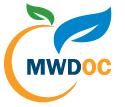Alex Heide, Water Resources Analyst, MWDOC
As dry conditions persist throughout the State, is our region prepared for the possibility of another drought? These two planning documents help ensure the continued high level of reliable water supplies for Orange County citizens, rain or shine.
In the midst of what is shaping up to be a critically dry year, the Municipal Water District of Orange County (MWDOC) reaffirmed its commitment to forward looking resources planning by adopting its 2020 Urban Water Management Plan (UWMP) and Water Shortage Contingency Plan in May.
MWDOC’s UWMP is prepared every five years and required by the California Water Code. Since the drought of 2012-2016, State Law regarding UWMPs has undergone significant expansion and revision to account for the historic water supply impacts that were felt across the State. The Law was revised to recognize that prolonged droughts, changing groundwater conditions, regulatory changes, and changing climatic conditions have all had an impact on each water supplier’s water reliability determinations.
UWMPs are a long-term plan that presents an evaluation of a water supplier’s reliability over a long-term 25-year horizon. The forward looking document provides an assessment of the present and future water supply sources and demands within MWDOC’s service area. The UWMP also presents an update on MWDOC’s water resource needs, water use efficiency programs, water reliability assessment and strategies to mitigate water shortage conditions. It is an important tool for water agencies to ensure appropriate planning for long term balancing of supply and demand.
As part of the UWMP development, MWDOC worked with its 28 member agencies, the Orange County Water District, and the Cities of Anaheim, Fullerton, and Santa Ana to update the regional water demand analysis. The analysis found that over the next 25 years, total water demands within the MWDOC service area are projected to increase by about 17% from approximately 428,000 acre-feet (AF) in 2020 to approximately 501,000 AF by 2045. This demand projection considers such factors as current and future demographics, future conservation measures, and ground and surface water needs.
As presented in the UWMP, MWDOC has taken numerous steps to ensure its member agencies have adequate imported water supplies. Through the investments that MWDOC and its Member Agencies have made in large scale water-use efficiency programs and state-of-the-art local supply projects the region has the bolstered ability to respond to changing water supply conditions. The imported water supplies available to the MWDOC service area are projected to meet full-service demands based on the findings by the Metropolitan Water District in its 2020 UWMP in 2021 through 2045 during all year conditions.
In addition to the adoption of the 2020 UWMP, MWDOC’s Board of Directors also adopted a brand new Water Shortage Contingency Plan (WSCP). The WSCP is a strategic planning document designed to prepare for and respond to water shortages. The WSCP is MWDOC’s operating manual that is used to prevent catastrophic service disruptions through proactive, rather than reactive, management. In addition to being MWDOC’s operating manual for water shortages, the WSCP also contains MWDOC’s predetermined six shortage levels, communications protocols, and decision making process for its annual water supply and demand assessment to determine if a supply gap exists for the upcoming year.
These two documents are important tools that MWDOC uses for both short-term and long-term water resources planning. With California’s high degree of variability year-to-year on wet and dry conditions, these two planning documents help to ensure the continued high level of reliability water supplies within to the 2.3 million residents within MWDOC’s service area.
The Urban Water Management Plan, Water Shortage Contingency Plan, and associated documents can all be found on the MWDOC website www.mwdoc.com.

